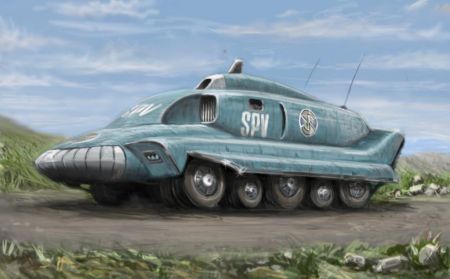Special purpose vehicle: Difference between revisions
Amwelladmin (talk | contribs) No edit summary |
Amwelladmin (talk | contribs) No edit summary |
||
| Line 9: | Line 9: | ||
Fourteen years later, retired botanist [[Herbert Fonesca]] came across neat piles of tax losses when on a forest walk with his grand-children which the children traced all the way to back to a mating pair of concealed film espievies, of a type never before seen in Panama.<ref>Fonseca should have realised trouble was in store: the very thing about film partnerships is that they are ''not meant to be traceable''</ref> | Fourteen years later, retired botanist [[Herbert Fonesca]] came across neat piles of tax losses when on a forest walk with his grand-children which the children traced all the way to back to a mating pair of concealed film espievies, of a type never before seen in Panama.<ref>Fonseca should have realised trouble was in store: the very thing about film partnerships is that they are ''not meant to be traceable''</ref> | ||
Then, in 1964, Jersey paleontologist [[Ichabod Mourant]] discovered a colony of “[[Oeic]]s” (the word is derived from the Jèrriais for “imaginary legal entity” and is pronounced “[[Oik]]”) nesting in the archive stacks of Guernsey’s ''Library for the Illiterate''. Since then [[ | Then, in 1964, Jersey paleontologist [[Ichabod Mourant]] discovered a colony of “[[Oeic]]s” (the word is derived from the Jèrriais for “imaginary legal entity” and is pronounced “[[Oik]]”) nesting in the archive stacks of Guernsey’s ''Library for the Illiterate''. Since then [[espievie]]s have proven robust migrants and flourished in many fiscal climates. | ||
===Domestication=== | ===Domestication=== | ||
The [[espievie]] was first bred in captivity in a famous scientific collaboration between [[Calder]] and the [[Maple brothers|Godfrey and Maginot Maple]] brothers, then working in the [[George Ugland]]’s zoological menagerie in [[George Town]]. The site is occupied today by the [[Ugland House]] orphanage, which is headquarters of an industrial breeding programme for [[espievie]]s of all kinds, meaning that the continued survival of this freak of financial biology is, for the foreseeable future, assured. | The [[espievie]] was first bred in captivity in a famous scientific collaboration between [[Calder]] and the [[Maple brothers|Godfrey and Maginot Maple]] brothers, then working in the [[George Ugland]]’s zoological menagerie in [[George Town]]. The site is occupied today by the [[Ugland House]] orphanage, which is headquarters of an industrial breeding programme for [[espievie]]s of all kinds, meaning that the continued survival of this freak of financial biology is, for the foreseeable future, assured. | ||
Revision as of 18:12, 15 December 2020
 An espievie going about its charitable purposes yesterday
|
Special purpose vehicle /ˈspɛʃ(ə)l ˈpəːpəs ˈviːɪk(ə)/ (n.)
A unique species of joint stock company[1] first discovered in the lush forests of George Town, Grand Cayman by dour Scottish naturalist A. J. N. Calder in 1926.
Discovery
For many years Calder believed the creature he had found — the “Common” or “Cayman Exempted” espievie (genus consortium restrictum culpam caymanium) — was unique in the world. But Calder’s, and our, world was repeatedly rocked over the next thirty years as naturalists found variants elsewhere
The first to do so was L. B. G. T. Appleby who discovered the Bermudan reinsurance espievie not too far from the Caribbean along the Gulf Stream, of course, in 1939.
Fourteen years later, retired botanist Herbert Fonesca came across neat piles of tax losses when on a forest walk with his grand-children which the children traced all the way to back to a mating pair of concealed film espievies, of a type never before seen in Panama.[2]
Then, in 1964, Jersey paleontologist Ichabod Mourant discovered a colony of “Oeics” (the word is derived from the Jèrriais for “imaginary legal entity” and is pronounced “Oik”) nesting in the archive stacks of Guernsey’s Library for the Illiterate. Since then espievies have proven robust migrants and flourished in many fiscal climates.
Domestication
The espievie was first bred in captivity in a famous scientific collaboration between Calder and the Godfrey and Maginot Maple brothers, then working in the George Ugland’s zoological menagerie in George Town. The site is occupied today by the Ugland House orphanage, which is headquarters of an industrial breeding programme for espievies of all kinds, meaning that the continued survival of this freak of financial biology is, for the foreseeable future, assured.
Modern use
Most espievies are harmless and even friendly and can be useful around the garden, mulching up tax liabilities and so on. But occasionally they turn nasty. Poor Andrew Fastow was hounded to prison by three of his own raptors. Herbert Fonseca successfully bred Panamanian tax espievies for nearly sixty years, until an unfortunate leakage of publicity wiped out the whole population, and his laboratory, in 2016.
See also
- Cayman Islands
- Ugland House
- SPVs in Ireland
- Enron and its benighted raptors
